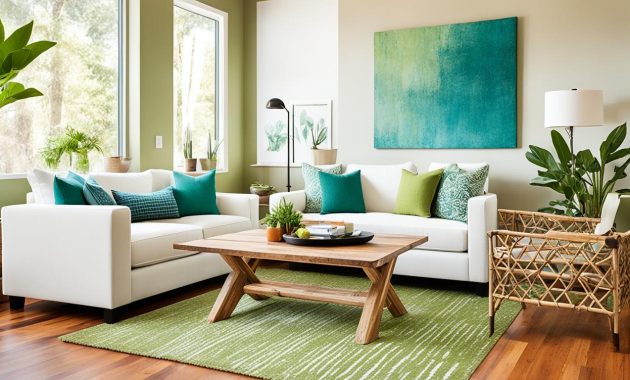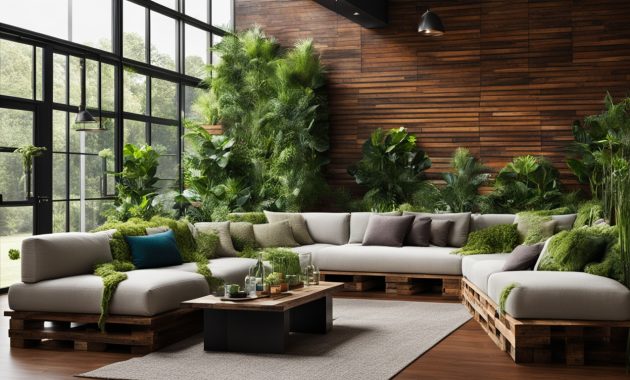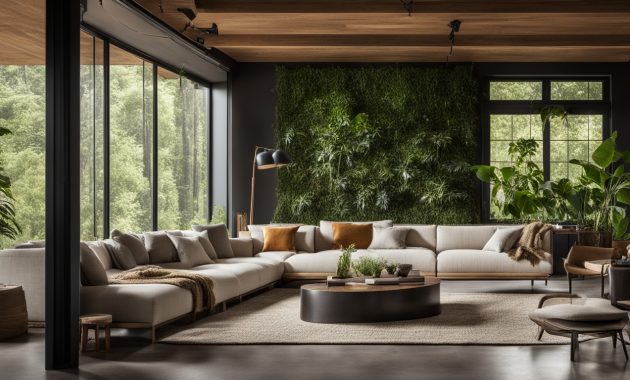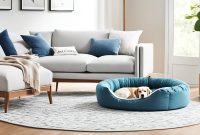The sunlight poured into Alice’s living room, revealing a remarkable change. Once filled with synthetic materials, now it radiated warmth. This was all thanks to her wise choice of sustainable materials. She was excited to tell you all about her journey in eco-friendly interior design.
In sustainable materials for eco-friendly interior design, we will look at green choices. These options help the planet and make your home look better and work well. We will cover renewable resources, bio-based materials, and recycled products. Also, we will explore how energy-efficient solutions are changing home decoration.

Get ready to learn about the sustainable materials changing interior design. This journey is about making smart choices for the planet one step at a time.
Sustainable Materials: A New Era of Eco-Conscious Design
Today, more people care about how their choices affect the planet. So, the demand for sustainable materials is going up in interior design. This change is leading to a focus on materials that are natural, renewable, and recycled. These choices help reduce our impact on the environment.
Embracing Nature’s Bounty
Using green materials in interior design is gaining popularity. Materials like bamboo, cork, jute, and hemp are now at the forefront. These materials aren’t just environmentally friendly; they also create beautiful spaces. They play a part in making our world healthier.
The Journey Towards a Greener Future
The design world is responding to the call for more eco-friendly options. Both designers and homeowners are using innovative approaches. This includes using repurposed items and new, green materials in their designs. The aim is to have spaces that are kind to the earth and beautiful.
“The future of interior design lies in our ability to embrace sustainable materials and practices that minimize our environmental impact while enhancing the beauty and functionality of our living spaces.”
Renewable Resources: Nature’s Gifts to Interior Design
In eco-friendly interior design, materials like bamboo, cork, and natural fibers are shining stars. Thanks to their sustainability and beauty, they are popular choices. This popularity is because they offer an eco-friendly alternative to more traditional, less sustainable materials. They help create beautiful spaces that care about the planet.
Bamboo is called the “green gold” for a good reason. It grows fast, strong, and can be used for many things. You’ll find it in floors, furniture, and even on walls. Its elegant look and versatility fit well in both modern and green designs.
Cork is another favorite for eco-conscious designers. It comes from cork oak trees’ bark, so it’s a natural and sustainable choice. Cork is great for floors, walls, and for keeping a space quiet and cozy. It makes homes more comfortable and energy efficient.
“Renewable resources offer a refreshing alternative to traditional, resource-intensive options, allowing designers to create stunning spaces that prioritize both aesthetics and environmental consciousness.”
The design world has many more renewable options, like jute, sisal, and seagrass. These natural fibers bring a warm feel to a room. They are used in many ways, from rugs to curtains. Using them helps create a sustainable future.
People are increasingly interested in making their homes eco-friendly. Renewable materials are a big part of that. They make beautiful spaces that also help the planet. So, by choosing sustainable materials, we can all make a positive impact.
Bio-Based Materials: Innovative and Eco-Friendly
The field of interior design is changing a lot. People who care about the planet are looking for options that aren’t harmful. They are finding these in bio-based materials, which come from natural resources that grow back.
Exploring the World of Biomaterials
There are a lot of cool choices in bio-based materials. For example, insulation made from mycelium and textiles from hemp. These choices look good and are good for the earth. They often do better than the old materials in saving energy, being easy on the earth when they break down, and not harming the climate.
Benefits Beyond Sustainability
Bio-based materials do more than just help the planet. They also keep spaces warm and quiet better, last longer, and feel different in a good way. This meets the rising interest in designs that are both eco-friendly and feel nice. This progress means we’re heading towards new and improved ways of making and decorating our homes.
“The future of interior design lies in the embrace of sustainable, bio-based materials that not only protect our planet but also enhance the overall living experience.”
From mycelium-based insulation to hemp textiles, the use of bio-based materials is changing how we do interior design. As more people want designs that are easy on the planet, these materials are getting more popular. This growth shows they have a big role in the future of design.
Recycled Materials: Giving New Life to Waste
Many now choose recycled materials for sustainable interior design. This choice lets designers use waste in new ways. It makes unique pieces and cuts down on environmental harm. Plus, it adds creativity and individuality to any room.
The Art of Upcycling
Upcycling is changing old materials into things that are worth more. It’s key to being eco-friendly. Designers use old items to make new furniture, decor, and even buildings. This way, they keep things out of landfills and add beauty to the world.
There are so many materials to work with. Things like wood, fabrics, and old machine parts can all find new use. Artists and designers turn these old materials into something fresh. They make furniture, lights, and decorations. This also helps cut down on new resource use.
“Upcycling is more than just a trend – it’s a philosophy that embodies the essence of sustainable living. By transforming waste into something extraordinary, we not only reduce our environmental footprint but also cultivate a deeper appreciation for the beauty that can be found in the discarded and forgotten.”
Recycled materials make a big impact on how our homes look and feel. They add a special look and story to our spaces. Choosing recycled design means embracing creativity. It leads to homes that are not just beautiful but also make a positive difference.

Choosing recycled materials is a step towards a greener world. It’s becoming more popular as people look for eco-friendly options. The movement is changing the way we design our homes. This means our living spaces can be both beautiful and better for the planet.
Non-Toxic Interior Finishes: A Breath of Fresh Air
In the world of eco-friendly interior design, keeping people healthy is key. There’s a growing need for designs that are good for the planet. This means lots more focus on using non-toxic finishes. These products make indoor spaces look better and breathe easier, perfect for a healthier lifestyle.
You can find a lot of non-toxic options, from paints with low-VOCs to natural stains. They are all about eco-friendly design. Homes and offices can look amazing without risking bad air quality. This is because these finishes are made without harmful chemicals.
Choosing non-toxic finishes brings many wins. You help the planet. Many of these finishes use renewable or recycled stuff. They keep the air clean. And they make sure the future is better for everyone.
More and more, people want non-toxic finishes in their spaces. It’s a big trend for a good reason. It makes your space beautiful and safe. By picking these eco-friendly options, you’re doing your part for a better, healthier planet.
“Sustainable design is not just about reducing our environmental impact, but also about creating spaces that promote the well-being of those who inhabit them.”
Choosing the right finishes is a big part of a green future. It’s not just about looks. It’s about making sure our choices keep us and the planet feeling good. This is how we make beautiful spaces that are friendly to the environment and our health.
Sustainable Materials for Eco-Friendly Interior Design
Now, more than ever, people care about making eco-friendly design choices. Interior design is focusing on using sustainable materials. These materials are not just good for the planet. They also show how creative and beautiful eco-design can be.
Natural and renewable resources like bamboo and cork are very important. They are taken from the planet without using it up. Bamboo is becoming very popular because it grows fast. It is strong and can be used in many ways, like for floors, furniture, and decorations.
Bio-based options are now becoming popular too. These are made from things like agricultural waste and mycelium. They are a great alternative to traditional materials. Mycelium-based products, for example, are good for insulation and countertops. They are both good for the environment and perform well.
- Sustainable materials for eco-friendly interior design include natural and renewable resources, bio-based options, and recycled materials.
- These materials not only contribute to a greener living space but also showcase the creativity and innovation that can be found in sustainable design.
- Bamboo, cork, natural stone, and mycelium-based materials are just a few examples of the sustainable materials revolutionizing the interior design industry.
“Sustainable materials are the foundation of a truly eco-friendly interior design that not only reduces our environmental impact but also inspires us to live in harmony with nature.”
The world is moving towards sustainable living. The interior design world is using sustainable materials for eco-friendly interior design more and more. By using these materials, spaces can be beautiful and good for the Earth.

Energy-Efficient Interior Products: Reducing Your Carbon Footprint
Energy-efficient interior products are key to making your home greener. They use the newest tech to cut down on energy usage and lessen your home’s impact on the planet. This helps in lowering your overall carbon footprint.
Embracing Smart Solutions
The market is full of smart ways to make your home eco-friendly. Think LED lights, smart fridges, and better insulation systems. These products not only save energy but also reduce your bills. They’re your ticket to a sustainable, money-saving home.
LED lighting is leading the charge in smart, energy-saving tech. They use way less energy than old light bulbs and last a lot longer. This means fewer replacements and less waste. So, they’re a top pick for eco-friendly folks.
Smart appliances are changing the game, too. They learn your habits and adjust their energy use accordingly. By putting these devices in your home, you’re making a big step towards a greener lifestyle.
Then there’s insulation and advanced climate control. They maintain a comfortable atmosphere using less energy. This not only lowers your bills but also makes your place more cozy and eco-friendly.
“The path to a sustainable future starts with the choices we make in our own homes. By embracing energy-efficient interior products, we can create spaces that are not only visually appealing but also environmentally responsible.”
When shaping an environmentally conscious design, think about these modern energy-efficient interior products. They’re a great way to step up, cut back on waste, and support a healthier planet.
Environmentally Conscious Design: A Holistic Approach
Environmentally conscious design focuses on more than just materials. It looks at the whole life of a space, from building it to how it’s used. This approach is key to making places to live that are both green and good for people.
The core of this type of design is thinking about the future. It’s about making places that are good now and for those who come later. This means picking eco-friendly materials and energy-saving ways to lessen a place’s impact over time.
And it doesn’t stop there. Environmentally conscious design also cares a lot about human health. It uses designs that boost air and light quality, making spaces nicer to live in. Such a mindset is not just good for today but helps build a healthier future for everyone.
To do this kind of design well, you need to do many things. You have to:
- Choose materials and finishes that are good for the Earth
- Use tech that saves energy and supports renewable power
- Design for air and light to come in naturally, keeping the place cool
- Focus on keeping the air inside as clean as possible
- Think about every stage of a space’s life, from when it’s built to when it ends
Taking this multi-layered approach helps everyone. It makes homes and buildings that are friendly to nature and people. Moving toward environmentally conscious design is a continuous effort. But it leads to long-term benefits for our planet and all its living beings.
Natural Fiber Furnishings: Comfort and Sustainability Intertwined
In eco-friendly interior design, natural fiber furnishings are essential for comfort and earth-friendliness. These items are made from nature’s bounty. They bring a mix of texture, warmth, and strength to any room, making it a snug spot.
Texture, Warmth, and Durability
Linen, wool, and jute are special because they make every room look better. Their feel and natural warmth can’t be matched by fake stuff. They are also built to last, so you’ll enjoy them for many years. That’s real value for your money.
“The beauty of natural fiber furnishings lies in their ability to seamlessly blend form and function, creating spaces that are both visually stunning and environmentally conscious.”
Natural fiber furnishings not only look good but also help the environment. They’re usually easy on the planet since they’re biodegradable and come from renewable sources. This makes them a smart choice for anyone wanting to live more green.
- Linen: A timeless classic known for its breathability and durability
- Wool: Offering unparalleled warmth and natural insulation properties
- Jute: A versatile and resilient fiber that adds a touch of rustic charm
The need for sustainable materials keeps increasing. So, the natural fiber furnishings world is growing fast, offering many choices for cozy and green homes. By choosing these items, you’re making your space nicer and helping the planet. It’s a win-win for everyone.
Conclusion: Embracing a Sustainable Future
The world of sustainable materials for interior design is always changing. There are many eco-friendly options to choose from. These can make your home beautiful while helping the planet. Choices include materials from renewable sources and recycled items. So, we have lots of ways to create green, attractive interiors.
Using sustainable materials for eco-friendly interior design is key. It’s a way for homeowners and designers to support a greener Earth. These choices improve the quality of our living spaces. They do this by being good for the environment and for people.
We should keep moving ahead by picking environmentally conscious design. Let’s look for ways to lower our impact on the Earth. Together, we can design homes that are lovely and kind to our planet. This leads us to a future where both our homes and Earth flourish.
FAQ
What are some sustainable materials for eco-friendly interior design?
For eco-friendly interior design, use materials like bamboo, cork, and natural fibers. Also, consider bio-based materials and recycled products. They are durable and look good. Plus, they help the planet by reducing harm.
What are the benefits of using renewable resources in interior design?
Renewable options like bamboo, cork, and natural fibers are great for eco-design. They last long and add beauty. By using them, you also help improve air quality and lower carbon footprints.
How do bio-based materials differ from traditional materials?
Bio-based materials come from natural sources, not chemicals. For example, mycelium-based products. They lessen harm to the earth. Yet, they work just as well as traditional materials.
What are the advantages of using recycled materials in interior design?
Using recycled materials creates unique pieces and cuts waste. This practice is creative and lowers manufacturing’s harm to earth. It’s a way to make new things while helping the environment.
Why are non-toxic interior finishes important for eco-friendly design?
Non-toxic finishes make the air safer indoors. They include paints and stains without harmful chemicals. They are vital for a healthy home.
How can energy-efficient interior products contribute to sustainable design?
To make homes greener, use LED lights, smart appliances, and good insulation. These products cut energy use and reduce harm to the earth. They also save money in the long run.
What are the key principles of environmentally conscious design?
Think about a space’s life from start to end. Use sustainable items and methods. Prioritize health and the environment. This way, you create a good place for everyone that doesn’t hurt the earth.
What are the benefits of using natural fiber furnishings?
Furnishings from natural fibers are strong, comfy, and look nice. They come from the earth and go back to it when they’re done. They make a home feel welcoming and kind to the planet.



